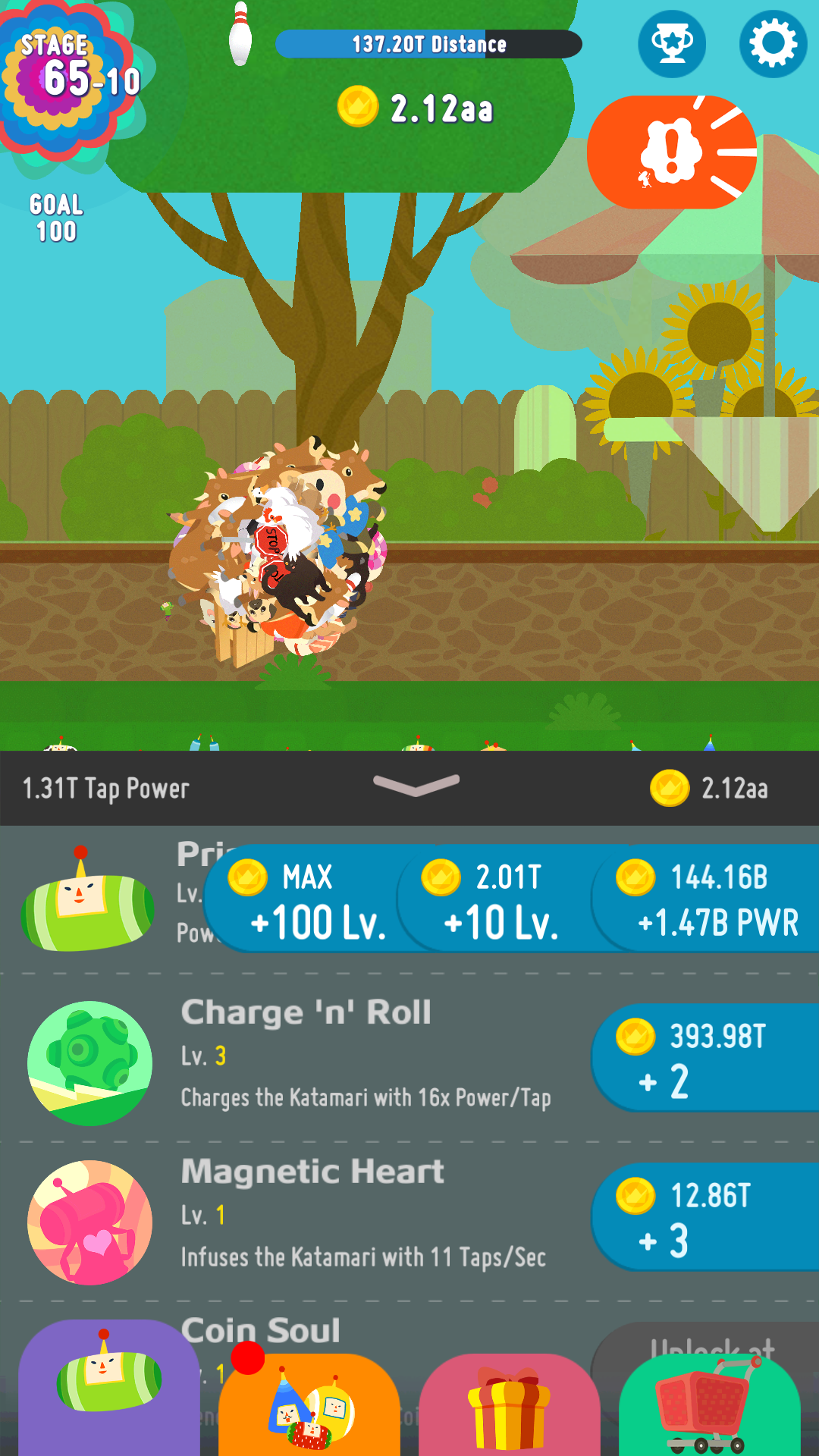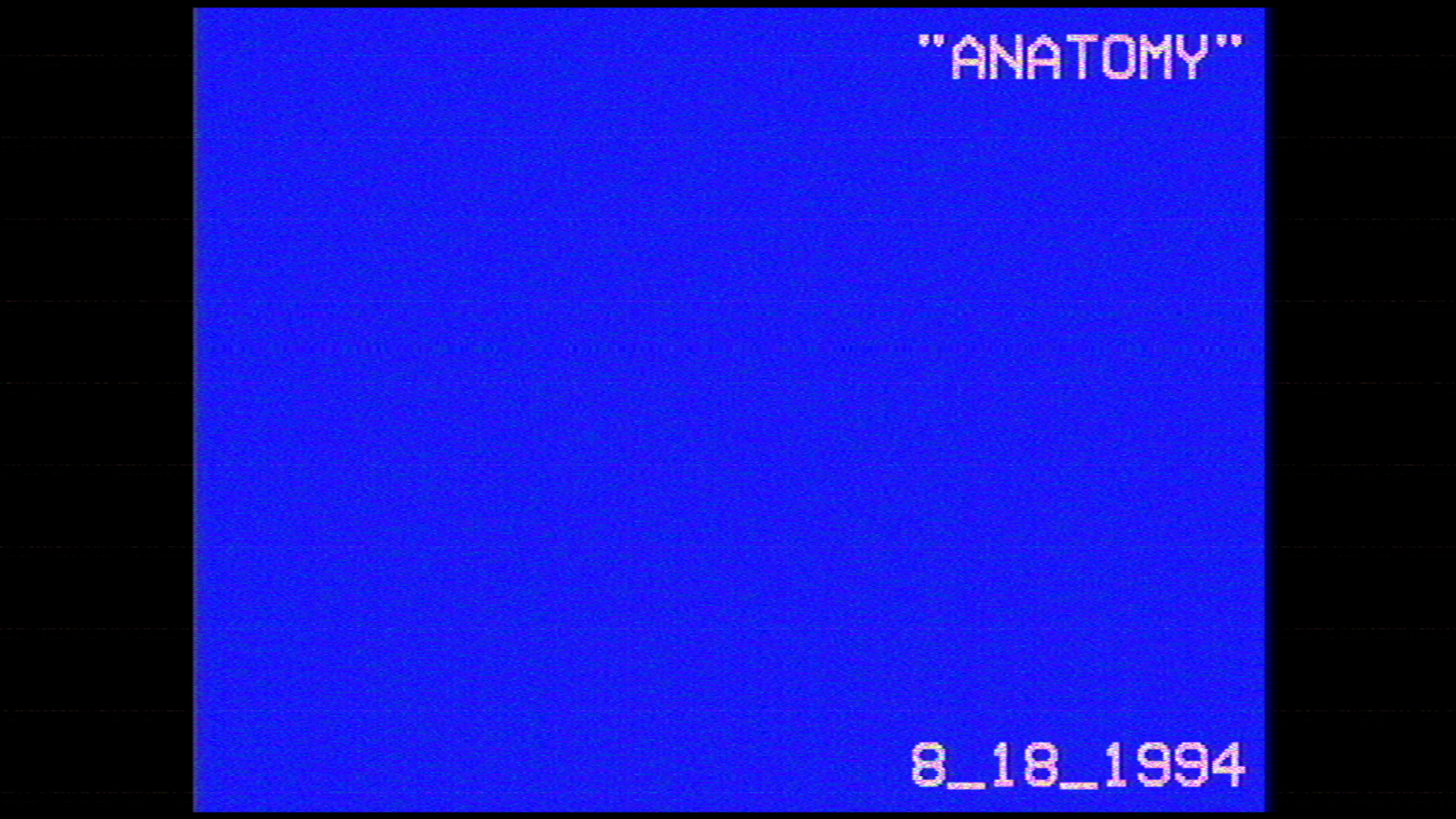Tap My Katamari
I've never been a huge fan of the "Katamari is an indictment of consumerism" crowd, even if it does include Keita Takahashi, the series' creator. Any critique of "consumerism" is likely to set my eyes rolling, because it never amounts to much more than moralizing. Imagine my surprise, then, when the latest installment – coming long after Takahashi divested himself of the series – presented the most compelling form and rhetoric of that criticism yet, and has so become one of my favorite Katamari games ever. The form is of a tapper, or clicker, or idle or incremental game; the genre is still confused enough to not have a unified name. The rhetoric is physical. The game's argument takes place in your wrist, and it was compelling enough that I spent the week of Global Game Jam in a wrist guard, fearing the onset of an RSI.
The form of the idle game is important because in it is an embedded critique. The story goes like this: Ian Bogost, having been subject to a speech by Zynga's president at the Game Developer's Choice Award, decided to make a critique of the then-dominant genre of social games that Zynga had made a fortune with on Facebook. Bogost deconstructed these with a game called Cow Clicker, in which the player clicked a cow once every six hours to accrue currency. The game's popularity made it more than an academic exercise, and the ultimate consequence was the popularization of the idler genre. In these games, the player rarely does more than click (or tap) to accrue currency. This currency is, generally, used to purchase upgrades that have two purposes: allow the player to click less, and accrue currency faster. As Jeff Gerstmann is fond of saying, the appeal is simple: "The numbers just keep going up."
Gerstmann, who is possibly (Bogost included) the foremost critical authority on idle games, is not making an idle observation. The numbers going up is one of the more visible aspects of videogames design practices. It surfaces just how reliant videogames are on the reward loop, over and above its ostensible function as only a motivator for execution or skill. From its origin as a critique of predatory practices and poor design that turned out to be uniquely compelling to its current status as a genre-without-a-name, the idle game is uniquely suited to be a critical vehicle with teeth.
The year before Bogost sat through the Zynga president's presentation, Keita Takahashi told attendees of the Game Developer's Conference that, "I think I successfully expressed my cynical stance towards the consumption society by making Katamari - but still I felt empty when the objects were gone." In the six years between Katamari Damacy's release and Takahashi's talk, I remember hearing people float that theory around, between jokes about How High Would You Have To Be To Make This, and finding it uncompelling. Beyond even the formal category of games of complicity – your Spec Ops: The Lines and Trains and The Beginner's Guides and so on – which attempt to clarify a reading of engagement or interactivity along a moral line, reading Katamari Damacy as a polemic against consumerism makes it, at best, along the lines of the arguments that situate JRPGs as nothing more than capitalist productivity simulators with even less of a leg to stand on. Takahashi's own affective response to his game is striking, but as analysis it suggests no path other than a tired Louis CK or Jonathan Franzen bit. We live in a fallen society, it claims, and the blame lies on its inhabitants, not its architects.
* * * * *
If videogames are unique, then they are unique insofar as they can ruin your hands. The zenith of 'interactivity' is Mew2King refusing to see a doctor as his career slowly implodes. "Passive entertainment" can't compete with that. There is no phenomenology of film that can make you aware of just how often your wrists are required in daily life.
Tap My Katamari – Endless Cosmic Clicker's mechanics are simple. You tap to roll the katamari a specific distance, and every amount of that distance holds an object which it rolls up. These objects also spit out coins; one at first, and eventually more. With coins, you can buy upgrades to the Prince, or cousins who will roll the katamari without your input. Every tenth object is a gating mechanism, a "Time Attack Challenge," after which you advance to the next level. After certain levels you gain a Star Token, which can be used to buy Presents. These are functionally permanent powerups, as opposed to everything else which gets lost when you turn your katamari into a star, which requires upgrading the Prince to level 600. The strategy, roughly, is to play the game for a couple of hours until the cousins are powerful enough to generate sufficient coins to keep the whole thing going at a clip, and then check in every few hours. You do this less and less until you get to the point where you need more presents, and start it all again.
The most economical way to get coins, of course, involves tapping as fast as possible for a brief period of time. Whether you get this by the King of All Cosmos gifting you with the Royal Touch (for the nominal fee of watching an ad) or through the Coin Soul powerup that refreshes once an hour, rapid tapping becomes central to overcoming the stickier gates. The most effective way is to place both hands to either side of your phone and tap with each finger consecutively on both hands; doing this requires a very odd angle of your wrists.
This demand – that the body mutate to the desires of the software – is still not an analysis, but it is at least a reflection that does not demand a moralism. If the consumer society is unique, then it is unique in its demands on bodies; not to produce, but to watch the numbers keep going up.
The influences that Anatomy wears on its sleeve range from Videodrome to Gone Home, The Haunting of Hill House to House of Leaves. Its tension is created by rifling through a very dark house, but its horror is pure theory. Anatomy is a modest Cyclonopedia with as much, if not more, to offer.
Anatomy begins with the player in a house, which she wanders through. Doors either open or rattle when clicked, until the player finds a tape and player. When played, someone who gives the vibe of a clinical psychologist begins speaking of a theory of houses. At each segment's end, a bit of text informs the player of the location of the next tape in the house. After finding a number of tapes, and hearing the elaboration of the theory of the house as metaphorical organism, the game quits itself out.
At this point, the rattling is worth noting. As much as it is the darkness that produces the tension, and eventually the narration that develops the horror, it is the doors that don't open that develop the creepiness. The sound is a doorknob rattling in a way that is pitch perfect for someone trying to escape or break in, except it only occurs when you intentionally interact with a door. It is creepy not just because of its associations and possibilities, but because it requires a return to the fundamental question of your place within this world. As cliché as it sounds, the simple sound effect is making it clear that what's to be afraid of isn't a monster closet bursting out and spooking you, but the possibility that you are the monster in the closet from the start. In the unzipped folder that hosts Anatomy's .exe is a text file titled "SPOILERS - PLAY BEFORE READING." It is the obvious next step after the game quits, as there's hardly anything to spoil; you may wonder if there's not more game in here, or at least an explication of some kind. Read, the spoiler is simple: relaunch the game. It takes multiple playthroughs to experience in full.
It takes a couple more launches and automatic quits for the player to experience a Kitty Horrorshow environment, and its inclusion is deeply weird. The worlds of Dust City and Chyrza and Rain, House, Eternity are powerful in part because of their decontextualization. Situated explicitly as an outside, what should by all accounts be very familiar in its weird, unsettling imagery becomes, well, defamiliarized. That's a strange thing to say!
Before we get to the house itself, some words about how the game incorporates quitting and launching as a mechanic. It is a historical peculiarity of games that any state which signifies an end to progress – especially a temporary end, from which it is possible to return nearly immediately – is elided into the concept of death. While Anatomy never makes this elision explicit, it is felt. Incorporating paratextual elements into the text has been a signature of Horrorshow's since at least Dust City, and the way Anatomy does this is both recognizable and innovative. Innovative in the sense that it subtly engages with critiques of the walking simulator, especially those that claim to be about gamey credentials but are really fixated on the absence of fail states. Failing – dying – is integral to the experience of Anatomy, and not in a narrative way; but, more importantly, not in the sense of an arbitrary skill check, either. Your floating camera dies without dying, allowing the house, which already exhibits its own agency, to rearrange itself in relation to you.
Which brings us to the most important part, and what makes Anatomy possibly my favorite game made by one of my favorite game makers currently going. Because Anatomy understands that the horror of the house is not the things it hides, or what it represents, or (least of all) how it may be breached, but the theory of the house itself. Because the house is both material and symbolic in absolutely immediate ways, any attempt at taking either of these aspects alone will inevitably get mired in the other's absence.
I've been beating this drum for years, but: ghosts are space. Particularly its becoming-linguistic. And Anatomy, more than possibly anything else I have ever encountered, gets that. What's to fear aren't historical events but the deformations that they leave on a place, and the possibility that the accumulation of those deformations might make it such that the place itself learns to speak. And in learning to speak, it would learn to negate. Anatomy's finale is literally a narration of that. It is incredible.
The theory of houses espoused in Anatomy is of the house as body. The tapes tell the story of living room as heart, bathroom as digestive tract, bedroom as mind, and basement as subconscious. The metaphors are questioned even as they are stated, though; both visually and audibly. The tape that tells the story of the bedroom as mind is in a master bedroom on whose walls are many pictures of teeth. The house as body is only a half-step to the game's ultimate conclusion: that, given enough time, the whole house might become a mouth. The visceral terror there is of the teeth that grind. The horror is of the tongue that lulls, that tells you its theories and asks you for favors, that misdirects and negates. Because dying is just part of the vernacular, so trivial as to be named when it has consequence. But when the space can speak, the space that is the image of the family, of the site of reproduction, of capital and its bubbles; even if it only speaks to tell you that it has a mouth, that is horror.

